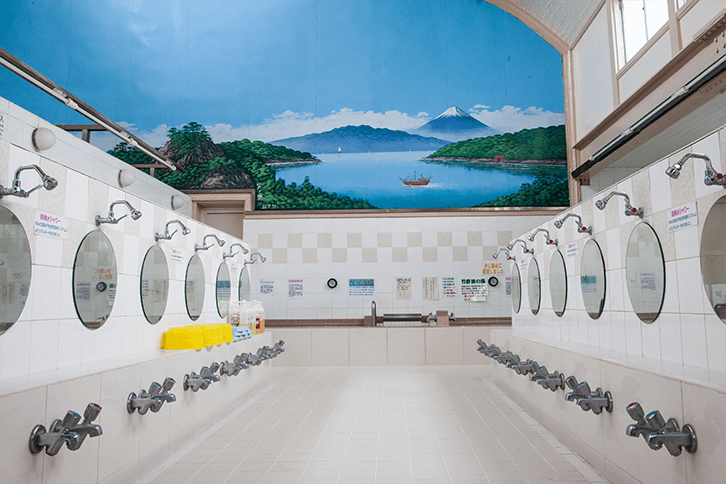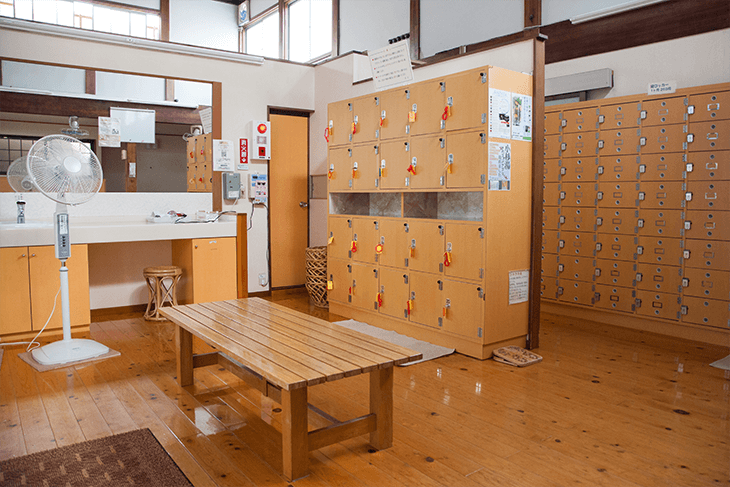
One of the must-do experiences for travelers to Japan is taking a dip in a communal bathhouse. The art of bathing in Japan has a rich history and is often celebrated in rural onsen hot springs resorts, where bathers can soak up mineral waters as well as spectacular natural scenery. But sento bathhouses, the humble, urban counterparts of onsen, are enjoying a post-pandemic renaissance and offer some truly unique cultural experiences for visitors.
-
01
Nostalgic reminders of Showa Japan
Usually distinguished by tall chimneys and traditional tile roofs, sento can be found throughout Japan, but are often located in dense residential neighborhoods. Many are nostalgic reminders of the Showa era (1926–1989), when they served as the only means for working-class users to get clean.
![Sento typically have several tubs for bathing, showers and faucets for washing and painted murals on the walls]()
Sento typically have several tubs for bathing, showers and faucets for washing and painted murals on the walls
Though it may feel intimidating at first, using a sento is a straightforward affair. Slip off your shoes at the entrance, store them in a cubbyhole, pay the attendant the bathing fee (usually around 500 yen), enter one of the gender-segregated changing rooms—be sure to go through the right door—and then strip down to your birthday suit, leaving your clothing in a provided basket or locker. Most bathers bring a hand towel into the bathing area, where there are numerous faucets and showers for washing; many but not all sento will have free soap and shampoo. The thing to remember is to wash and rinse off before soaking in the baths and not to put your towel in the water. Once you’ve adjusted—the hot baths are usually in the low to mid-forties Celsius—all you have to do is relax and enjoy the murals on the wall, often of Mt. Fuji.
![Changing areas come equipped with lockers for your belongings]()
Changing areas come equipped with lockers for your belongings
-
02
Sento numbers on the decline
While communal bathing in Japan has a history stretching back more than a thousand years to Buddhist purification rituals, the first public bath was built in Edo (the old name for Tokyo) in 1591. They played a vital role in the growth and reconstruction of the city over the next few centuries, especially after the Great Kanto Earthquake of 1923 and World War II, catastrophic events that left many in the capital without homes or bathing facilities. Recent decades, however, have seen baths and showers installed in all but the lowest-rent accommodations in Tokyo. This has resulted in a precipitous decline in the number of sento, from 2,687 in 1968 to 476 in 2022, according to the Tokyo Public Bathhouse Association. The coronavirus pandemic and rising fuel prices have been further challenges.
-
03
Sento with a modern touch
Sento operators have responded by updating their facilities with hangout spots targeting younger users. Some have added attractive new spaces with magazines and art exhibits for post-soak relaxation, and reached out to non-Japanese users by including multilingual signage. Others have included entirely new features for traditional sento: saunas, craft beer bars and turntables spinning vinyl records. These operators are not only reaching out to younger people who have not been sento patrons, they are trying to reinforce the community bonds that communal bathing can enhance. Besides just being a place to wash, “in Japan a bath has another, equally important role as somewhere to mentally and physically unwind,” sento author Shinobu Machida was quoted as saying in The Guardian. “Bathing in a sento can be a spiritual experience.”
If you’re looking to get your feet wet with sento, here are some a few in Tokyo that are trying to rethink their traditional approach through new ideas and younger customers. -
04
Kosugi-yu (Koenji, Suginami-ku)
Built in 1923 after the Great Kanto Earthquake, Kosugi-yu has a traditional irimoya-style (hip-and-gable) tiled roof, old-school coffered ceilings over the changing rooms and a large mural of Mt. Fuji extending over both segregated bathing areas. Listed as a National Registered Tangible Cultural Property in 2020, Kosugi-yu has several unusual features: a post-bathing relaxation room and art gallery, a laundromat and, in an adjacent building, Kosugi-yu Tonari, a shared space for eating, reading, working and relaxing.
![Kosugi-yu in Koenji]()
Kosugi-yu in Koenji
![Kosugi-yu also has a relaxation area complete with gallery space]()
Kosugi-yu also has a relaxation area complete with gallery space
GrapeHouse Koenji - Hostel, - Caters to Women
3-1-5Yamato-cho, Nakano-ku Tokyo

-
05
Hotta-yu (Nishiarai, Adachi-ku)
Dating to 1942, Hotta-yu is another traditional bathhouse that recently underwent a major update. Its bathing areas still have the traditional Mt. Fuji mural and low showers, but they’re hidden behind a sleek modern facade and reception area. Customers can also enjoy its herbal sauna and rotenburo outdoor bath.
![Hotta-yu in Nishiarai]()
Hotta-yu in Nishiarai
![The newly renovated sauna space at Hotta-yu]()
The newly renovated sauna space at Hotta-yu
![Hotta-yu also has an outdoor bath]()
Hotta-yu also has an outdoor bath
-
06
Kanamachi-yu (Kanamachi, Katsushika-ku)
Established in 1943 and renovated in 2021, Kanamachi-yu is a family-run sento currently managed by the fourth-generation owner. The exterior architecture is grand: the sweeping chidori-hafu roof and walls of stone and wood give this neighborhood bathhouse the air of a majestic temple. The interior is richly adorned with wooden carvings over the reception desk, traditional coffered ceilings and the must-have Mt. Fuji mural. Newer features include a sauna, outside wooden decks and gardens for added relaxation.
![The exterior of Kanamachi-yu in Kanamachi]()
The exterior of Kanamachi-yu in Kanamachi
![Kanamachi-yu has a mural of a red mount Fuji on the wall above one of their bathes]()
Kanamachi-yu has a mural of a red mount Fuji on the wall above one of their bathes
SpaceTokyoHouse-Kanamachi
東京都葛飾区東金町1-19-1 スペース1 - 401 Tokyo




 Go here
Go here










